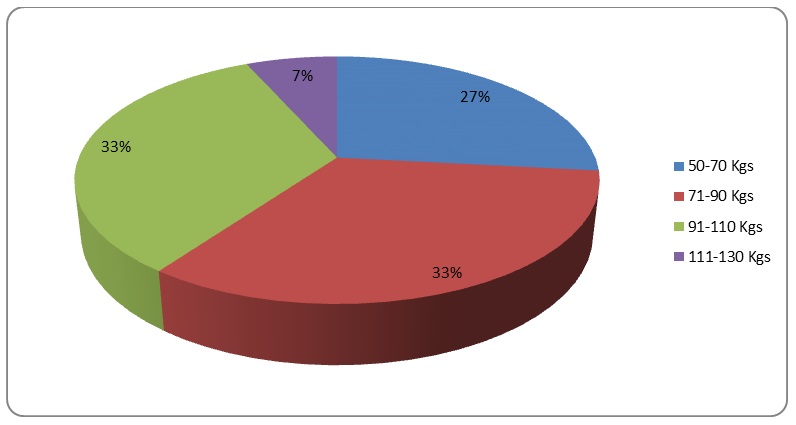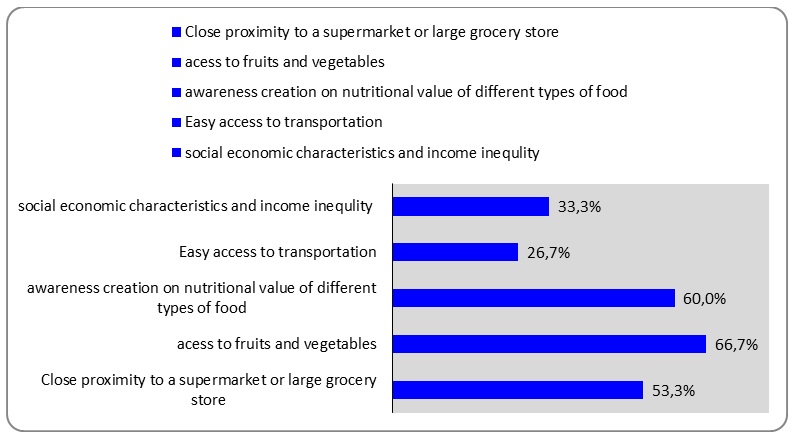Demographic Characteristics
The quantitative study engaged 30 participants to assess health and nutritional behavior of college students in Flinders University. Over half of the participants (53.3%) were aged between 26 and 30 years, while slightly over one-third (36.7%) were aged between 21 and 25 years. The rest of the participants were over 30 years old. 20 (66.7%) of the participants were male. All participants came from Saudi Arabia, were married, and spoke fluent Arabic. Two thirds of the participants (66.7%) were undergraduates and the rest were high school graduates. The weight distribution of the participants is demonstrated in the below figure.

The above figure clearly demonstrates that only four in every ten respondents (40.0%) weighed over 90 Kilograms. This observation is a valid indicator that many of the students in college lad a healthy lifestyle. 27 (90%) of the students said they visited the university cafeteria/canteen at least 1-2 times per week.
Main Study findings
The participants were asked to respond to a variety of issues concerning their health and nutritional behaviors. A Lickert-type scale was used to allocate scores to their responses, where a score of 1 represented “strongly agree” and 5 represented “strongly disagree.” The descriptive statistics for the responses are shown in the following table
Table 1: Descriptive Statistics for Responses on Health & Nutritional Behaviors among Students.
All the above variables were exposed to tests for normality to demonstrate if the scores were normally distributed. The significance for all the scores in half of the variables is more than 0.05, implying that these particular scores are normally distributed and hence the mean should be used to discuss the outcomes. For example, most students strongly agree with the fact that the price of food affects the food choices they made, and the scores for this variable are normally distributed as demonstrated by the low standard deviation.
Overall, using the median scores and interquartile range scores, it can be demonstrated that most students agree to the assertions that: 1) they are aware of the nutritional value of the food they take, 2) they always buy nutritious and healthy foods, 3) they always follow the dietary guidelines in choosing the food they eat. Consequently, these observations prove the hypothesis that nutrition and health knowledge influence college students’ choice of food intake. The null hypothesis – that nutrition and health knowledge does not influence college students’ choice of food consumption – is therefore, disapproved.
The food varieties students normally buy determine their health status due to the composition of nutrients. The preliminary results demonstrate that over one-third of the students (36.7%) usually buy rice, 6(20%) buy chicken, and 5(16.7%) buy pizza. Noodles, meat and sea food are also common among students. All these foods are high in nutritional value, implying that the nutritional and health knowledge that students have influence their food purchases. It is important to note that 28 (93.3%) of students make food purchases outside the school cafeteria, implying that students perceive home-cooked food as more nutritious and of high health value. Again, this observation has important ramifications on the food choices that students make.
Lastly, a multiple response question was posed to participants, with the view to gain important insights into nutritious food and how students afford the food without necessarily using a considerable chunk of their financial resources. 18 (60%) of the students said that creating awareness on the nutritional value of different types of food made them aware of some varieties that are less costly but contain high nutritional value. Additionally, 20 (66.7%) argued that the accessibility of fruits and vegetables within the university and in their home environments critically determined their health status. The rest of the distribution is shown in the figure below.

The above figure demonstrates that a considerable proportion of students are aware of the fact that close proximity to a supermarket or a large grocery store will directly impact their intake of food perceived to be of high nutritional value. Additionally, the figure shows that students are cognizant of the fact that economic/financial standing will influence the types of food they take. These observations further prove the hypothesis that nutrition and health knowledge influences college students’ choice of food intake.